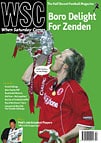 It’s 14 years since Napoli were Italian champions led by Diego but, as Roberto Gotta explains, while he has grown ever larger the club and crowds have shrunk alarmingly
It’s 14 years since Napoli were Italian champions led by Diego but, as Roberto Gotta explains, while he has grown ever larger the club and crowds have shrunk alarmingly
Diego Maradona has not come back to Naples for a while. He’s visited Italy a number of times, accepting fees of up to £10,000 for appearances on local television stations, ski slopes (he stood in the snow in shorts), carnival parades and – although this was for free – children’s hospitals, the latter probably having made nurses and parents happier than the kids, who obviously had no idea that the chubby figure was once one of the world’s greatest footballers.
In one bizarre incident that sums up the mess Maradona’s life has been for the last decade, his biological son from Naples, whom he fathered with a local woman during his heyday, ambushed him on a Tuscany golf course a few months ago, which was apparently the only way The Great Diego would acknowledge his existence after a court had decreed he was the youngster’s father.
But no Naples. It is perhaps as well he never came back, as the comparison between the current state of Napoli and that when the team won Serie A titles in 1987 and 1990, with the 1989 UEFA Cup sandwiched between them, would be too much to bear.
It is not a coincidence that Maradona’s shadow still looms over the city where he enjoyed football – and life, especially after hours – so much after his arrival in the summer of 1984: Napoli have not had much to cheer since and the current season has seen the team involved in what has become a customary struggle to keep their Serie B status.
Turmoil behind the scenes has been the main reason for Napoli’s collapse, which means only a quarter of the 70,000 regulars who filled the Stadio San Paolo for decades now bother turning up. Corrado Ferlaino, the long-time owner who sold most of the best remaining players in 1994 in order to save Napoli from bankruptcy and automatic relegation to Serie C, gradually lost support after Maradona was run out of town following a failed drug test, but his successors have all failed to revive the club. Ferlaino himself is now a hated figure in the city after being revealing in a newspaper interview – followed by, what else, a statement in which he said he’s been misinterpreted – that Napoli had cheated their way to the 1990 title, when a coach advised Brazilian midfielder Alemao to fake a head injury after he had been struck by a coin in a game at Atalanta: Napoli were given an automatic 2-0 win by the Italian Federation and, if that was not enough, Ferlaino revealed Napoli had been on the end of some sympathetic rulings by referees which had damaged their main rivals, Milan.
That Milan themselves passed over the chance to ask the authorities to overturn the outcome of that season and hand them the scudetto says a lot about Italian football, where no one usually dares denounce anything in case their own shady dealings are exposed. But the whole business helped further deepen the gloom of Napoli fans.
Giorgio Corbelli, who comes close to the definition of serial owner having already bought and sold three Serie A basketball clubs, had bought Napoli a few years back and felt it necessary to make it clear Ferlaino had no part in the new set-up, but lack of progress and growing indifference convinced him two years ago it was time to accept a bid from a shareholder, hotel magnate Salvatore Naldi. Naldi has so far been unable to shake Napoli out of their torpor and his time at the helm has been marred by fan violence and the hiring and sacking of four coaches with no apparent progress in sight on the field. After saving the club but acknowledging he can’t carry on alone, Naldi has asked for help, but no one seems interested once they hear about the debts of tens of millions of euros: last summer, Napoli were one of the clubs whose membership of Serie B was temporarily suspended when it emerged they had produced suspect financial guarantees.
So many names have been mentioned as possible partners – among them US hotel giants Marriott, who would like to have a say in what the club does with the proposed long-term lease of the San Paolo – that it is easy to understand why frustrated fans have turned to other leisure activities on Sundays. One could involve taking a stroll near the street named Decumano Inferiore. Next to a cafe sits a small shrine to Maradona, complete with a couple of photos, a relic of the Great Man – a hair taken from his conspicuous mane of the late Eighties – and a monstrance, a cup used in Catholic churches to show the blood of Christ for communion, full of “Neapolitan tears”. Indeed.
From WSC 206 April 2004. What was happening this month